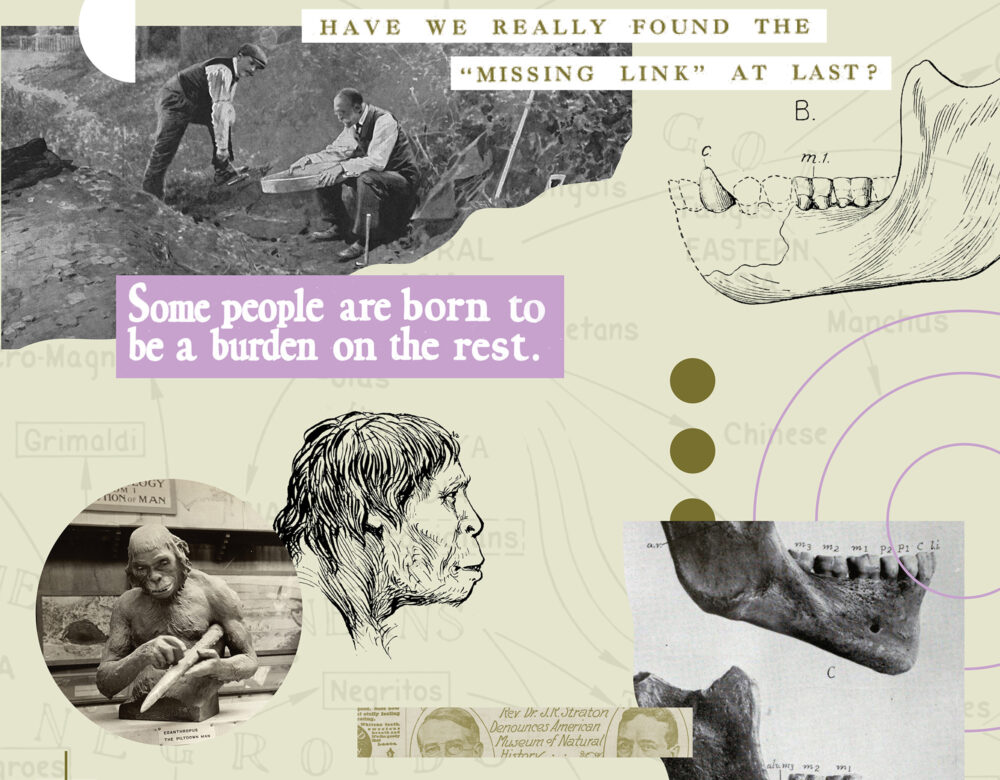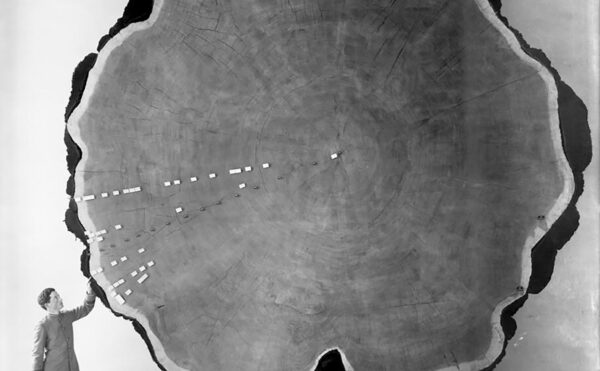Charles Dawson was a lawyer, though perhaps in name only. As a young man in the 1880s, he took a greater interest in the stories of the earth. He collected fossils, prehistoric artifacts, and anything else that could give him a glimpse into England’s distant past. He dedicated years to this passion, and by the age of 31, he had been made an honorary collector of the British Museum and a member of both the Geological Society and the Society of Antiquaries.
The Wizard of Sussex, as he was dubbed by local tabloids, unearthed Roman statuettes, Stone Age hand axes, and ancient timber boats in his tiny corner of England. But these findings paled in comparison to his ultimate and most famous discovery—the Piltdown Man.
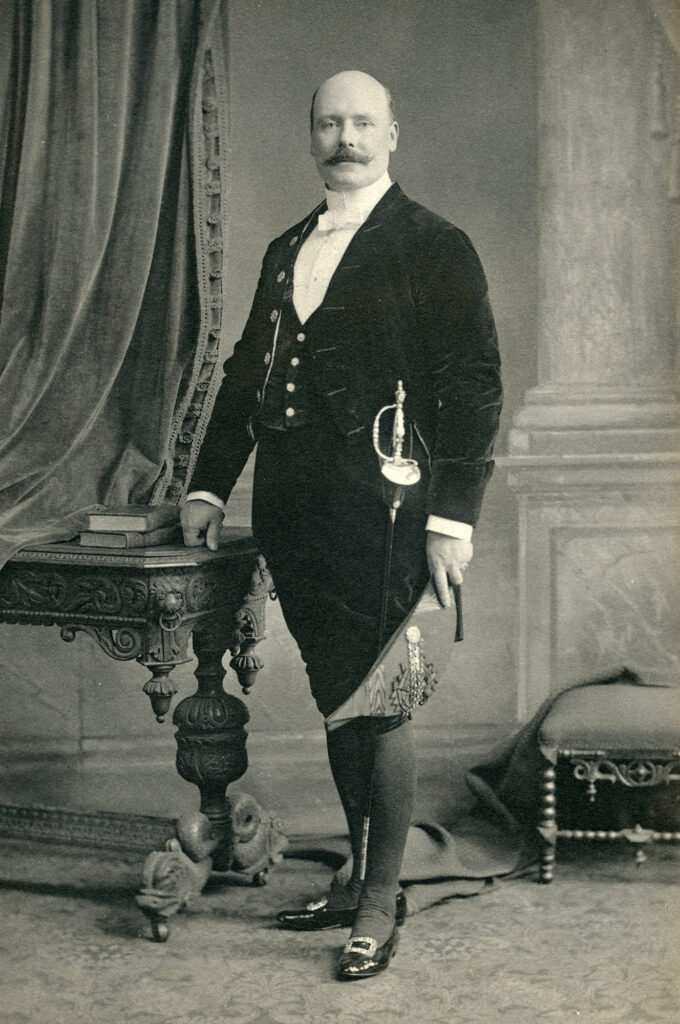
As a senior solicitor in Uckfield, Sussex, Dawson played an active role in his community’s civic affairs. He was the steward of a variety of local estates, including Barkham Manor in the village of Piltdown. There, in 1908, he was approached by a workman palming a thick, muddied chunk of something he thought Dawson would enjoy. It was a skull cap, fragile and decaying, but unmistakably human.
Dawson sensed this artifact was of immense scientific importance, but when he poked around the spoil heaps of the construction site for more evidence, he found none.
It wasn’t until 1911 that, as he walked the grounds of Barkham Manor, he came across a second, much larger cranial piece jutting from a spoil heap. He instantly recognized the fragment as part of the same individual. In February 1912, he showed the specimens to his acquaintance Arthur Smith Woodward, a geologist at the British Museum, who was similarly impressed. Within a few months, the pair recruited a team to systematically excavate the leftover gravel pits from construction at the manor.
They found seven more cranial fragments; the right side of a robust, apelike jaw with two intact molars; and a small assortment of animal bones and stone artifacts. The scientists eventually estimated the age of the skull fragments at 500,000 years old. In 1915, Dawson would find three more fragments at the Piltdown site that belonged to a second, separate 500,000-year-old skull.
The importance of these discoveries could not be overstated.
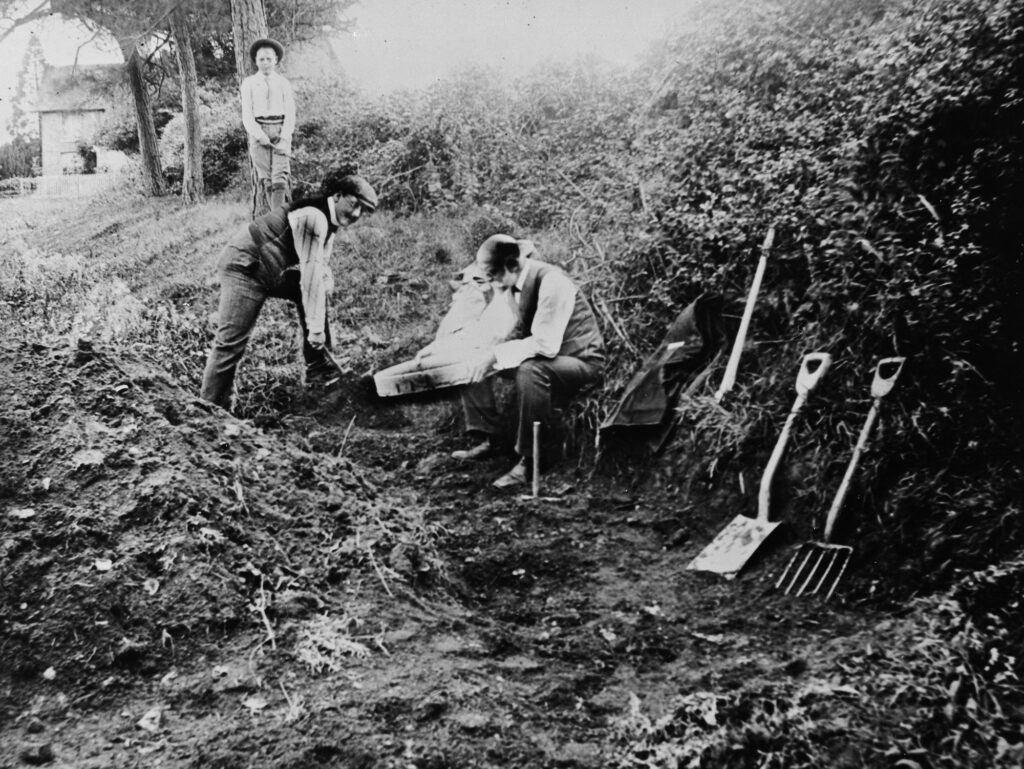
Since the 1840s, scientists in Western Europe had been developing a theory of human evolution that proposed the existence of a creature in transition between ape and human. Charles Darwin himself endorsed the idea of this “missing link,” and natural historians ventured around the world in search of such a creature. Potential missing links were popping up in Indonesia, France, and Germany. But England, home to some of the greatest evolutionary scientists and academies, was so far bereft.
By the end of 1912, Dawson and Woodward were ready to present their findings to the Geological Society. Members crowded into the meeting room, eager to hear about “The Earliest Englishman”—their very own missing link. Dawson and Woodward’s evidence appeared sound. The specimens showed clear and consistent signs of degradation that indicated the remnants were all from the same period and place. The braincase looked exceptionally humanoid save for its remarkable thickness, which rivaled even that of Germany’s missing link, the Heidelberg Man. The jaw was as strong and simian as the scientists described, except for the flat, boxlike shape of its molars, which signaled development toward a humanoid diet.
Piltdown Man placed Britain’s name on the map of human evolution. There was only one problem—there’s no such thing as a missing link.
Evolution isn’t linear; it consists of multiple branching-off points, leaving behind countless species driven to extinction by climate change, disease, or simple bad luck. Nowadays, the absence of a single missing link in humanity’s phylogenetic tree is old news to scientists. But in the early 1900s, evolution was seen as an unswerving process in which humans developed progressively toward an end point of perfection. Piltdown Man, many believed, was proof that humans were becoming “better.”
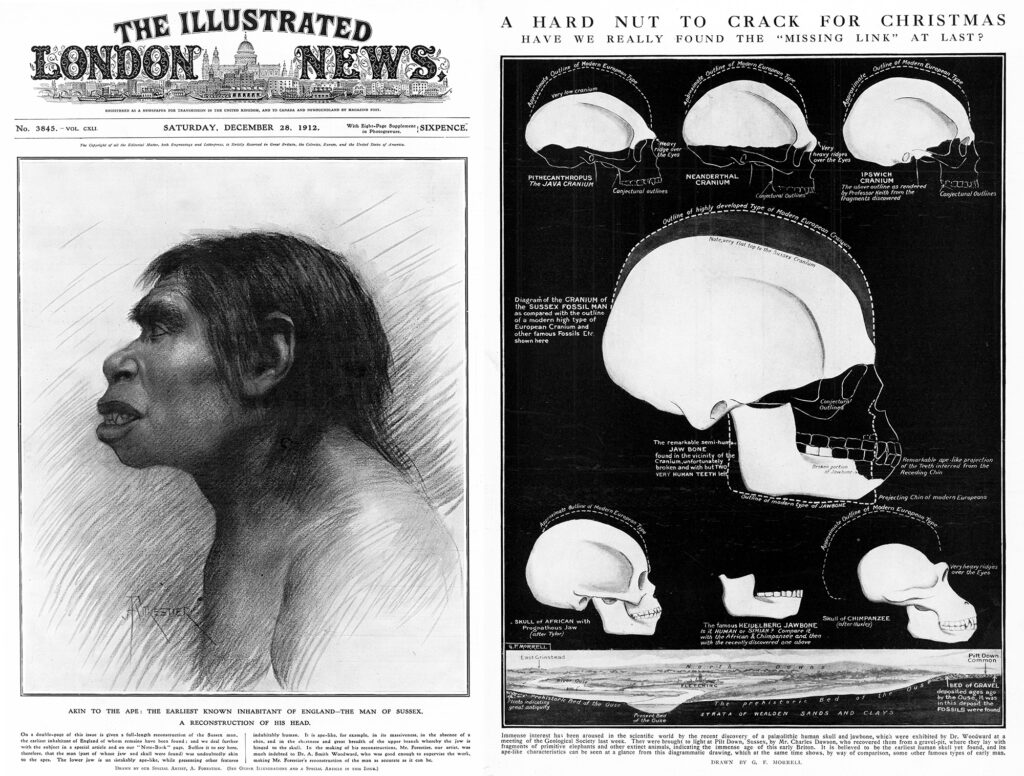
Despite the success of the meeting, opinion was split on the validity of the findings. The country’s scientific establishment joined Woodward in supporting Piltdown Man as evidence of England’s centrality in evolutionary science and history. For the leaders of wartime England, Piltdown Man was a source of nationalist and scientific pride. But some scientists, mainly anatomists and zoologists, weren’t convinced the jaw and skull cap matched up—the cranium was too distinctly human and the jaw too apelike to be from the same individual. Dawson and Woodward must have mistakenly grouped them together, they thought, since the fragments were found in the same deposit. Dawson died unexpectedly in 1916, so it was left to Woodward to defend their interpretation in the years that followed.
As a fellow geologist later concluded, “More than one zoologist of standing has maintained that the jawbone is that of a chimpanzee; but at present the balance of opinion favours Smith Woodward’s interpretation.”
The press was similarly divided. Some took a skeptical view. To them, Piltdown Man didn’t seem like the most overwhelming proof of the missing link theory. The evidence was there, but there just wasn’t enough. But the voices praising the scientific and historical significance of this discovery drowned out the doubters.
“The Heidelberg Man was certainly of the Neanderthal type; the Piltdown Man was much more of our own type,” reflected anatomist and Royal Society fellow Arthur Keith, as reported in The Lancet.
And the acclaim carried across the Atlantic.
“Natives of Great Britain can trace their ancestry further back than any other peoples on the face of the earth,” declared the Atlanta Georgian.
But no one had copped on to the real story—Piltdown Man was a devious hoax. Many of the people who should have noticed didn’t. They were too busy using Piltdown Man to peddle a nastier fraud.
In the years after its discovery, academics from across the United Kingdom, United States, and Western Europe took turns inspecting the specimens and drawing grand conclusions about human evolution from them.
Those in support of this missing link were often the most vocal. They claimed the remains and their English origins supported the idea that European, African, and Asian populations evolved separately. Humans didn’t evolve “out of Africa,” as Darwin had theorized.
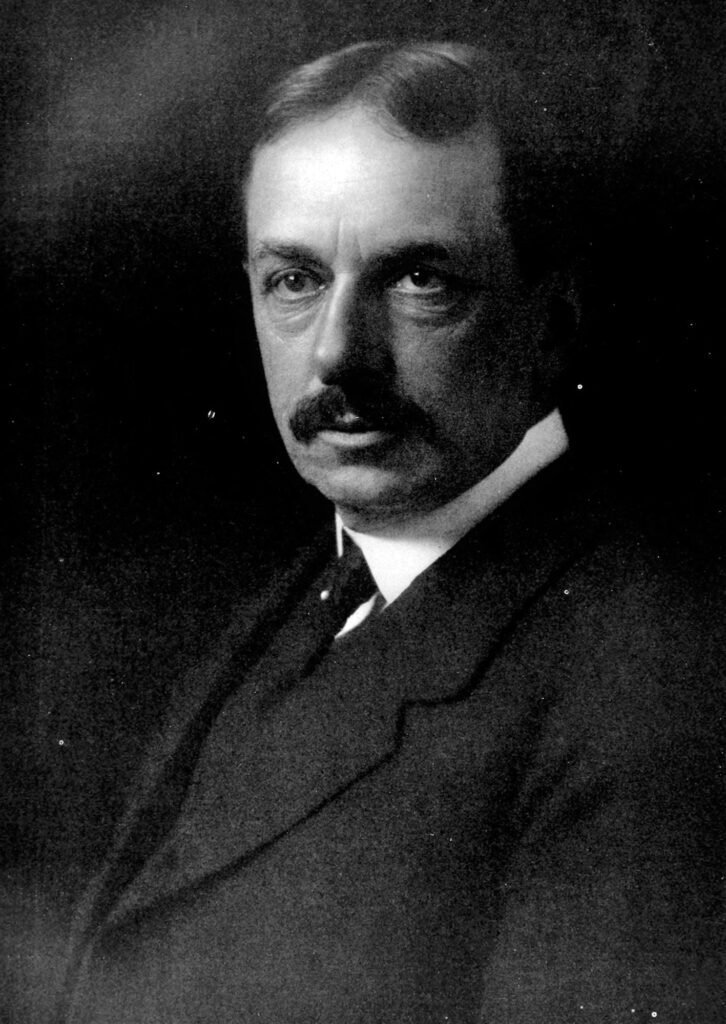
One of the most prominent supporters of this idea was paleontologist Henry Osborn. Osborn was born the son of a wealthy shipping magnate but traded a place in the family business for a professorship at Princeton University, where he taught comparative anatomy. By 1891 he was working at the American Museum of Natural History, becoming the museum’s president in 1908.
It took a decade for Osborn to give much credence to the Piltdown finds, but when he finally embraced them, he did so with fervor.
“The history of anthropology does not include any story of persistent exploration, discovery, and research more worthy of recognition and praise than that connected with the Dawn Man of Sussex,” Osborn wrote in his 1928 book, Man Rises to Parnassus, using an early name for the Piltdown discovery.
Osborn held that human evolution began far earlier than many scientists believed, as far back as 16 million years ago. More importantly, he argued that humans had evolved not from apes in the forests of Africa, but from a toolmaking forerunner he called Dawn Man, who roamed the high plains of present-day Mongolia and western China.
“In the Dawn Man was the potency of modern civilization,” he declared in a 1927 paper.
In Osborn’s view, environment dictated the pace and direction of evolution. Apes luxuriated in the abundance of the tropics and warm-climate forests, but that same abundance made evolution grind to a halt, even go backward. The harsh conditions of the Asian steppe, however, provided “the stimulus that carries man up the ladder of advancement.”
In piecing together his hypothesis of human evolution, Osborn set the date of the Piltdown remains as much older than originally proposed—all the way back to the Pliocene, roughly 2.5 to 5.3 million years ago. That made Piltdown Man an early link between Dawn Man and modern humans. Osborn also pegged Piltdown Man’s evolutionary emergence to roughly the same time the black, yellow, and white races first began to diverge.
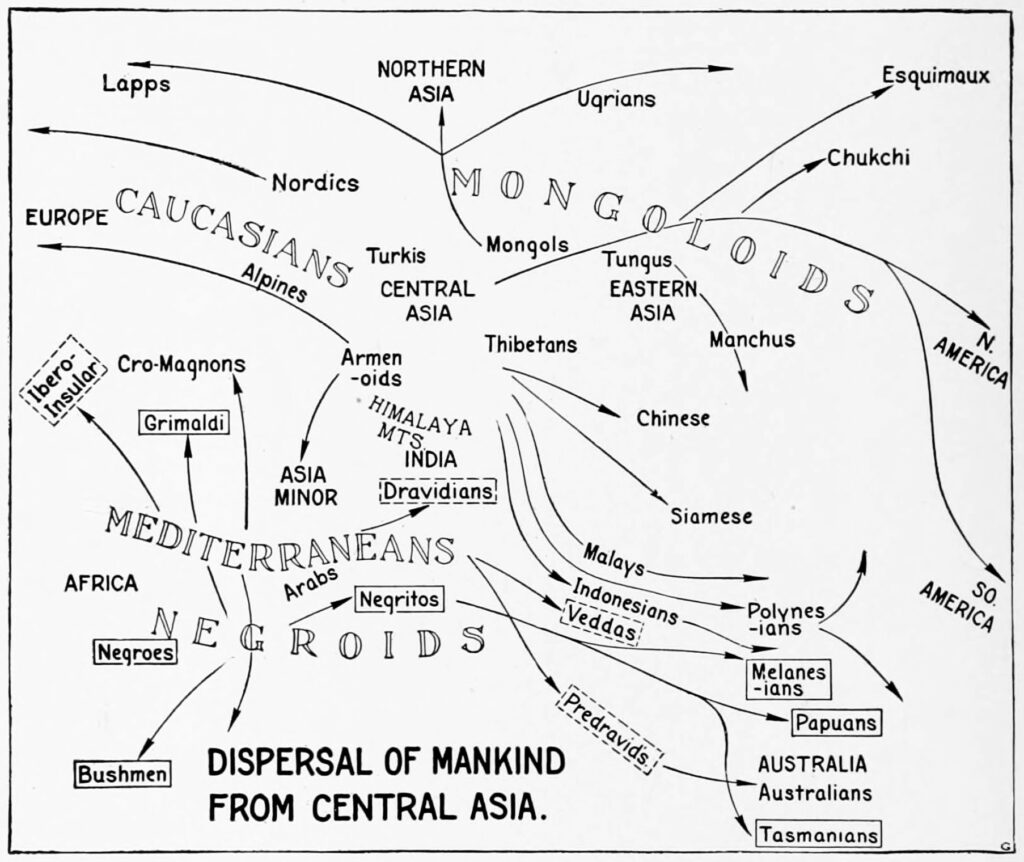
Osborn studied the intelligence and physical attributes of modern humans to reveal their distinct racial and evolutionary journeys. He judged the black race to be the oldest and, by implication, the least evolved; the white race had made the greatest advances. As with Dawn Man, environment did the heavy lifting in shaping the evolution of the races. As humans dispersed around the world, their chosen environment determined their status in the human hierarchy.
Proof of inherent biological and evolutionary difference between Europeans, Africans, and Asians was of acute importance to Osborn because he believed strongly in keeping these group separate.
“The 500,000 years of human evolution, under widely different environmental conditions, have impressed certain distinctive virtues as well as faults on each race,” he announced at the Second International Congress of Eugenics in 1921. “My opinion is that from biological principles there is little promise in the ‘melting pot’ theory. Put three races together, you are as likely to unite the vices of all three as the virtues.”
Osborn wielded his institutional power, social connections, and wealth to popularize this opinion.
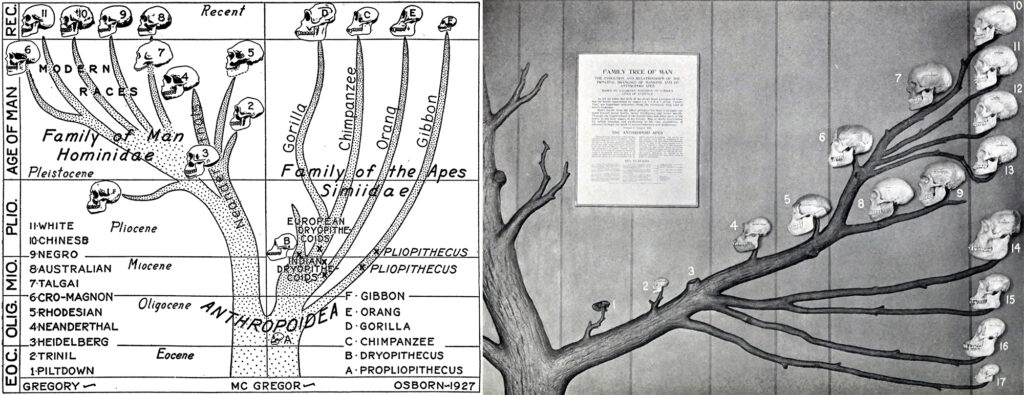
He co-founded the Galton Society in 1918 and American Eugenics Society in 1922, both dedicated to the advancement of the white race through eugenics. These groups sponsored “Fitter Family” contests, anti-miscegenation laws, and sterilization drives for unfit groups and “inferior” races. Osborn was also very politically active, passionately lobbying for the Immigration Act of 1924 that drastically limited immigration from Asia and Southern and Eastern Europe.
For Osborn, evolution may have followed a progressive path, but that didn’t mean the journey was unwavering. Nature had shaped each human race into an evolutionary form suited to its specific environment, but human action was now beginning to disrupt that harmony. Intermingling between the races, in particular, upset “the divine order of human origin and progress.” And so Piltdown Man’s primitiveness was also an implicit warning—racial mixing would cause the devolution of European people and set them on a course back toward their ancient ancestor.
“Racial deterioration appears to prevail throughout the world today,” Osborn wrote in Man Rises to Parnassus. “Care for the race, even if the individual must suffer,” he implored his readers.
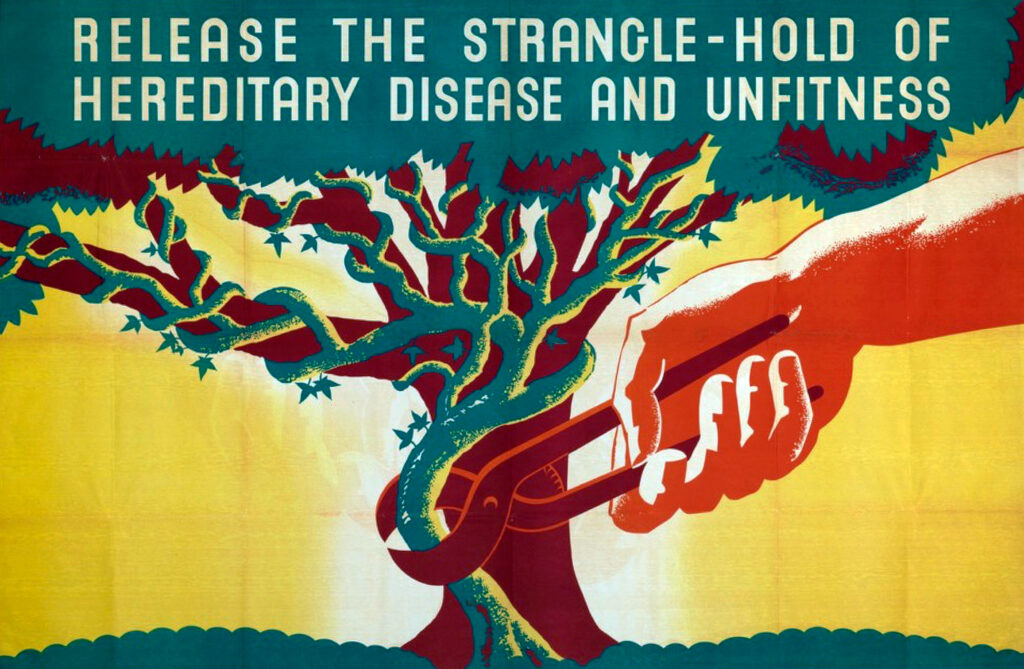
The popular press helped marry Piltdown Man, race science, and eugenic warnings. Soon after the discovery was announced, a British newspaper trumpeted Piltdown Man as proof of the races’ separate evolutionary origins.
And Piltdown Man was not only evidence humans could evolve backward—some thought he might be evidence that we already had. A 1913 New York Sun article on Piltdown Man’s cranial size declared, “They are asking in England, ‘If we are retrograding mentally, eventually, perhaps, to return to the brain capacity of prehistoric man, what’s the use?’”
Of course, not everyone bought into these representations of Piltdown Man, and scientists were quick to shoot down a direct connection between cranial size and “brain power.”
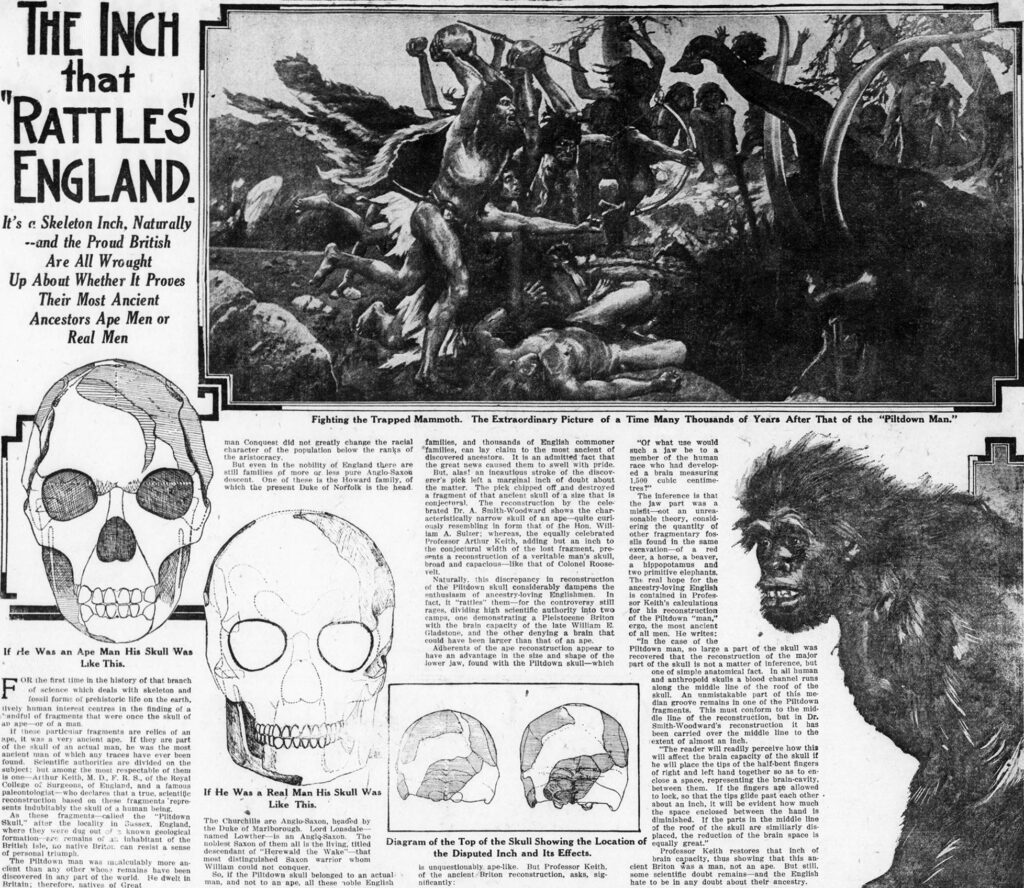
A lot of this disagreement came from anatomists who believed the reconstruction of the Piltdown skull from its fragments was simply inaccurate. Even slight changes to the angles at which the cranial fragments connected could tell a completely different story. Some reconstructions made the Piltdown Man’s brain case seem exceptionally large, bigger than that of modern humans. For critics, it was all too speculative.
But as the head of a well-respected museum with deep academic and publishing connections, Osborn had no trouble inserting his theories of human evolution and his interpretation of the Piltdown remains into newspapers, museum exhibitions, and textbooks. And to an audience predisposed to racist rhetoric, this was easy news to take in.
Osborn died in 1935. Woodward remained an ardent defender of the Piltdown Man’s significance until his death in 1944. But as the years passed, scientific interest in the Piltdown remains waned; they were mostly looked at as a curiosity. Without Woodward and Osborn’s advocacy, Piltdown Man and the ideas about racial evolution it represented were largely set aside.
Interest in the remains rebounded in 1953. That was the summer scientists Kenneth Page Oakley and Joseph Weiner conducted an extensive analysis that exposed Piltdown Man for what it truly was.
Their first source of evidence was physical. Under a microscope, the researchers clearly saw that the Piltdown molars had been filed down to resemble human ones. Theoretically, this damage could have happened while the specimen was alive. To investigate that possibility, the researchers took X-ray photographs of the teeth to look for signs of healing. Even though excessive wear had cut through the enamel and the inner dentine, the photographs revealed no new dentine had grown to replace it; the damage couldn’t have occurred while the subject was alive. Physical tests also pointed to the real source of the teeth. Using chimpanzee teeth, the team was able to recreate the wear patterns with nearly identical results.
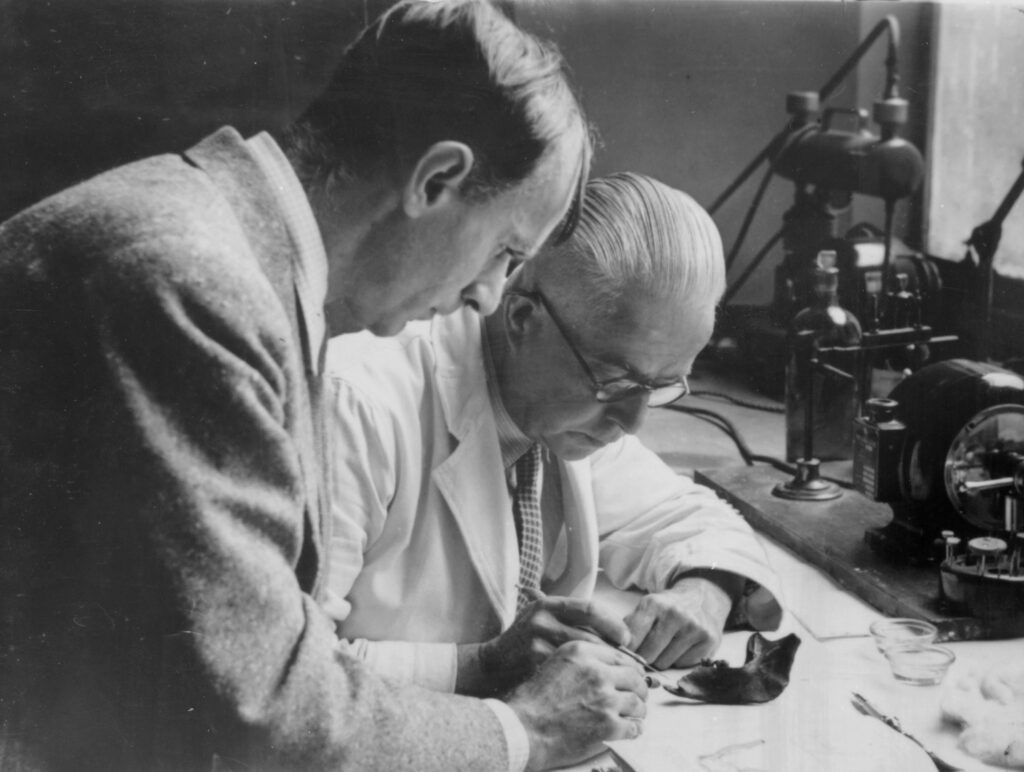
Chemical analysis revealed that the jaw fragments had been artificially stained with iron and chromic acid to look much older than they were. By drilling into the jaw fragment, Oakley and Weiner discovered that the discoloration on the jaw, originally used as evidence of its 500,000-year age, was superficial. By contrast, the cranial fragments had a deeper, naturally occurring stain, suggesting the humanoid cranium was significantly older than the apelike jaw.
The final step was then to determine how old these bones actually were. This was done through a combination of fluorine absorption dating and nitrogen dating. Buried bones absorb fluoride from the earth over time. The more fluoride present in a bone, the longer it has been buried and the older it is. The jaws and teeth contained 0.03% to 0.04% fluoride, whereas the braincase showed a fluoride composition of 0.1%. When compared to scientific estimates for the rate of fluoride absorption, results indicated that the jaw was modern and had stayed in the ground for hardly any time. The cranium was at most 50,000 years old, not the 500,000 years proponents had claimed.
To verify their results, Oakley and Weiner also conducted nitrogen dating using electron microscopy to observe the amount of organic matter remaining in the bone. As bones degrade over time, they lose organic components, such as nitrogen, to the soil. Fresh bones usually contain around 5% nitrogen. As the scientists guessed, the modern jaws and teeth were between 3.9% and 5.1% nitrogen in composition, while the ancient skull bones had between 0.6% and 1.4%. They had been buried a fair bit longer.
These results only reaffirmed what some scientists had hinted at all along. As early as 1914, William King Gregory, a paleontologist at the American Museum of Natural History, gently suggested, “It has been suspected by some that geologically [the Piltdown specimens] are not old at all; that they may even represent a deliberate hoax.”
However, Gregory ultimately endorsed the finds. Maybe he gave in to pressure from his boss, Osborn. Others also kept their suspicions hushed; the idea of accusing upstanding scientists of fraud, or even gullibility, was unthinkable.
But once news of Oakley and Weiner’s exposé broke, accusations roared from the British press.
“Fossil Hoax Makes Monkeys Out of Scientists!” crowed one headline. “Great Missing Link Hoax Rocks Scientists” declared another.
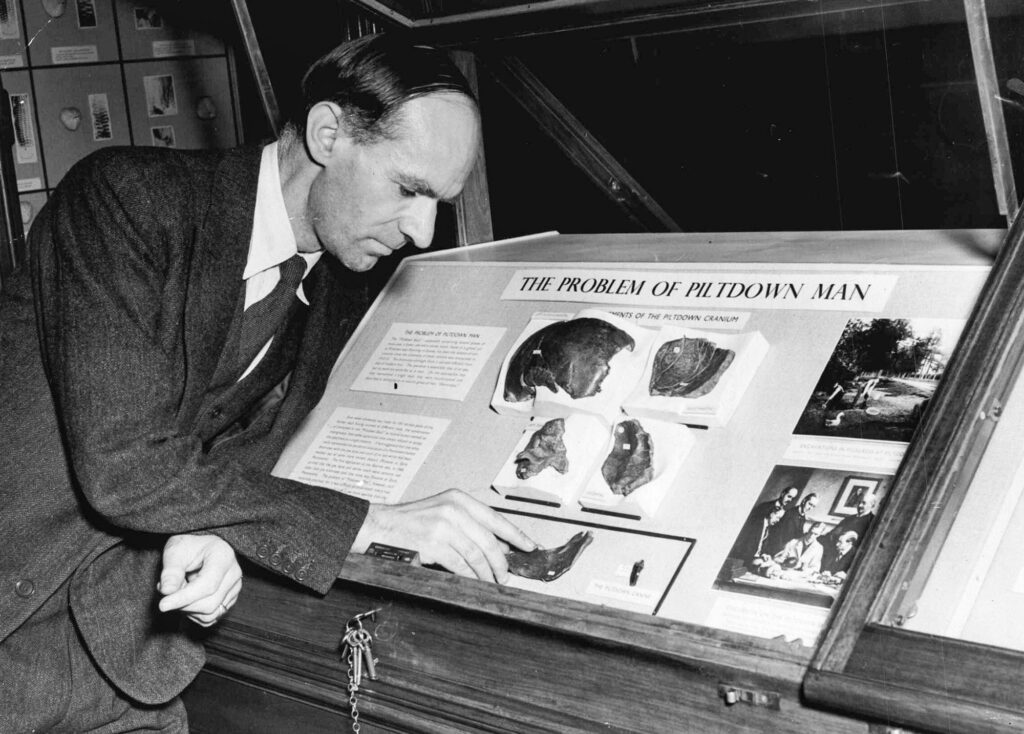
How had so many anatomists, paleontologists, geologists, and archaeologists who examined the remains missed these telltale signs? Why hadn’t early skeptics pursued the idea of fraud further? After all, they had access to the same X-ray imaging and microscopy as Oakley and Weiner.
But the biggest question on everyone’s mind: who managed to pull such a trick and why?
Dawson was everyone’s top choice—an amateur archeologist with something to prove and who had stumbled on a remarkable number of groundbreaking discoveries. At Piltdown, Dawson was consistently the only person with access to the site and specimens. And in the years that followed, it became clear that he had perpetrated many other fraudulent discoveries.
Nevertheless, anyone even tangentially related to Piltdown Man was accused of committing the fraud. Some suggested that Woodward, with his access to zoological and historic materials, had conspired with Dawson to create this hoax. Others were convinced one of Woodward’s colleagues at the British Museum had created the hoax as part of an elaborate scheme to disparage him. Another enduring theory was that Arthur Conan Doyle, yet another fossil hunter who conveniently lived in Sussex, forged and planted the fossils for Dawson to find. Surely the famed mystery writer and physician had the know-how.
Of course, there’s no real evidence Doyle had any role in the hoax. In 2009, paleoanthropologist Isabelle De Groote attempted to lay to rest the vast conspiracies by conducting computer tomography (CT) scans of the jaw and teeth. The scans revealed that the objects had been artificially altered with a consistency that suggests only one person—Charles Dawson—was the perpetrator. Yet scandalous versions of the Piltdown Man’s story have remained popular despite efforts to settle the matter.
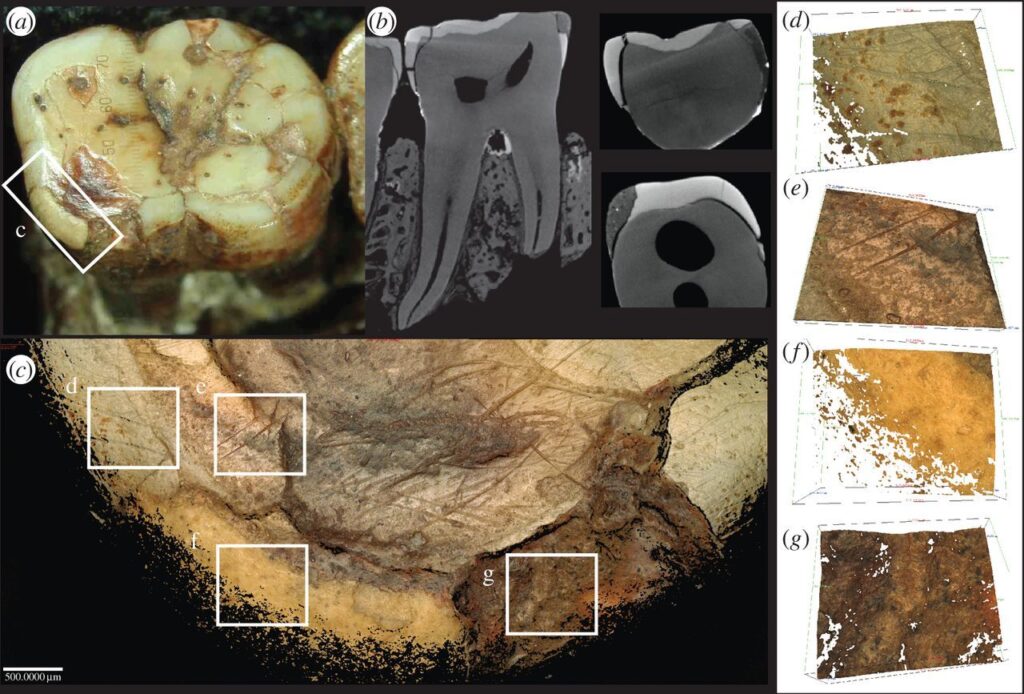
Decades of speculation have been devoted to identifying the culprit or culprits of the Piltdown hoax and their motivations, but perhaps a more important question centers on why they were successful. Dawson pulled it off with a rudimentary understanding of human anatomy and dyes. Yet scientists allowed themselves to be fooled for more than 40 years.
Archaeology—where fantasies about lost worlds, hidden treasures, and forgotten civilizations are abundant—is still fertile ground for this mischief. Television shows such as Ancient Aliens and Ancient Apocalypse feed the idea of an explainable gap—a missing link, perhaps—in human prehistory during which extraterrestrials or the holdovers of a long-lost civilization handed ancient peoples the technology archaeologists unearth today. These shows are rooted in the same kind of fallacies that grounded Piltdown Man—thin evidence, skewed facts, and veiled agendas.
Yet these far-fetched theories aren’t limited to the entertainment industry; they have remained a part of scholarly archaeology for decades. Textbooks peddling Henry Osborn’s ideas on evolution were a steadfast part of American biology curriculum well into the 1970s.
By that time Piltdown Man’s scientific relevance had been torpedoed, but new theories popped up to elevate Europeans’ place in human history. The Solutrean hypothesis posited that Europeans were responsible for populating North America about 20,000 years ago, traveling via large sheets of drifting ice in the Atlantic Ocean. To support this idea, archaeologists pointed to a specific style of American stone tools (called Clovis tools) and their resemblance to tools made by the Solutrean people of what is present-day France. The theory reads eerily like the premise of an Ancient Apocalypse episode and has been used to deny Native Americans as the first to populate the continent. Few scientists continue to endorse this hypothesis, but it remained popular in white supremacist circles well into the 2010s.
White supremacists also leapt on archaeological speculation around Kennewick Man, a set of nearly 9,000-year-old skeletal remains found in Kennewick, Washington, in 1996. They are some of the oldest human remains to be found in North America. Archaeologists observed the skull’s features appeared more “Caucasoid” than Native American and speculated that this early inhabitant might have come from present-day Japan, New Zealand, or even Europe. The skeleton’s supposed “Caucasian” race became fodder for white supremacists’ nativist rhetoric. It took two decades of lawsuits, scientific analysis, and advances in DNA testing to confirm what had been obvious to Columbia Basin tribes from the start: Kennewick Man was Native American. The remains were finally returned for reburial in 2017.
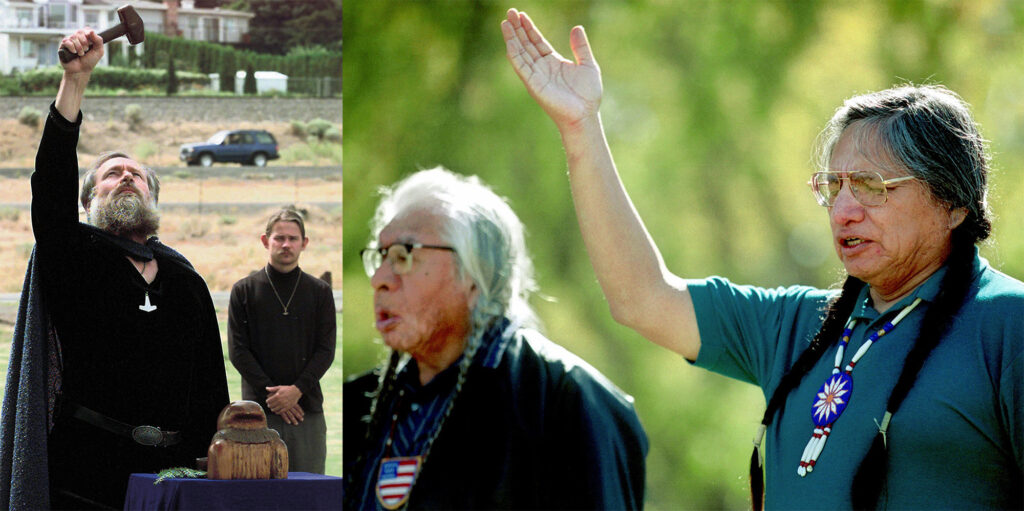
Whether it was about populating the Americas or linking together human evolution, archaeology as practiced by scientists and nonscientists alike has consistently sought outlandish explanations for events that don’t have one. In a field that relies on fragmentary physical evidence to answer existential questions, perhaps Piltdown Man was a natural outcome.
Maybe Piltdown Man arrived at the perfect time, when the tension between England and Germany was at its peak before World War I. A discovery rivaling Germany’s missing link surely would have bolstered England’s sense of national pride. Or maybe it was the scientific rationale for segregation and eugenics that scholars had been looking for. In the end, the Piltdown Man may have been one lawyer’s shot at archaeological fame or one institute’s answer to national prestige, but its effects on archaeology, both popular and scholarly, have been long lasting.
This article is part of Innate: How Science Invented the Myth of Race, a podcast and magazine project that explores the historical roots and persistent legacies of racism in American science and medicine. It is made possible in part by a major grant from the National Endowment for the Humanities: Democracy demands wisdom.

